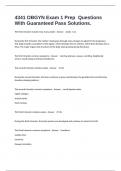4341 OBGYN Exam 1 Prep Questions
With Guaranteed Pass Solutions.
The first trimester includes how many weeks - Answer weeks 1-12.
During the first trimester, the mother's body goes through many changes to adjust for the pregnancy.
This stage includes conception of the zygote, which develops into an embryo, which then develops into a
fetus. The major organs and structures of the baby start growing during this phase.
The first trimester common symptoms - Answer morning sickness, nausea, vomiting, heightened
senses, mood swings and breast tenderness
The second trimester includes weeks - Answer 13-26.
During the second trimester, the fetus continues to grow and develop, the genitalia form and the fetus
develops sleeping patterns
The second trimester common symptoms - Answer round ligament pain,
nipple changes,
stretch marks,
food cravings
The third trimester includes weeks - Answer 27-40.
During the third trimester, the body systems are developed and continue to mature for birth.
The third trimester common symptoms - Answer heartburn,
swollen feet,
insomnia,
frequent urination
,EDC - Answer Estimated date of confinement
The estimated due date for a baby to be born (when the mother is confined due to the beginning of
labor)
EDD - Answer Estimated Due Date
Nagele's Rule (How do you determine?) - Answer Used to determine EDD
Obtained by taking the first day of the woman's Last Normal Menstrual Period (LNMP), subtracting three
months, adding seven days and adjusting the year, if necessary
Preterm labor - Answer Occurrence of regular contractions along with cervical effacement & dilation
before the end of the 37th week of gestation - if not stopped, preterm birth can occur.
Potential Complications of preterm birth - Answer neurodevelopmental disorders, respiratory distress,
infection,
congenital defects.
Intervention to manage and slow down preterm labor: - Answer 1) Tocolytic drugs (promotes uterine
relaxation by interfering with contractions;
2) antibiotics,
3) corticosteroids - can prolong pregnancy for 2-7 days
how are risk factors for preterm labor identified - Answer lab work and diagnostic testing:
- Fetal Fibronectin
- cervical length measurement
,Preterm Premature Rupture of Membranes (PPROM) - Answer Rupture of membranes which results in
loss of amniotic fluid prior to the start of labor - usually a sudden gush or steady leakage of fluid;
occurrence is 8-10% of all pregnancies
how soon after PPROM does labor begin - Answer Majority of women will begin labor within 24 hours
of membrane rupture
Potential risks of PPROM - Answer infections (because protective amniotic barrier is gone)
cord prolapse if engagement has not yet occurred
Ultrasonography - What is evaluated/scored? What do scores indicate? - Answer Real-time scanner
that produces a continuous picture of fetus on the screen: fetal heartbeat and malformations can be
assessed & measurements can be made;
standard component to identify pregnancy complications and to establish gestational age
Biophysical Profile - What is evaluated/scored? What do scores indicate? - Answer - uses
ultrasonography to assess fetal wellbeing;
- evaluates the fetus' tone (one or more full extensions of limb or trunk), breathing (one or more
breathing movements of >30secs), movement (three or more limb or trunk movements), and amniotic
fluid level (one or more pockets of 2cm. amniotic fluid).
- Overall, score of 8-10 considered normal; 6 or below is a red flag to further investigate fetal wellbeing
Amniocentesis - Answer Amniotic fluid is aspirated from the amniotic sac (between 15-20 weeks
gestation) to perform chromosome analysis and DNA testing
Amniocentesis Safety Concerns - Answer Infection,
pregnancy loss,
fetal needle injury
Amniocentesis Risk factors - Answer Family history or heredity trait of the following:
, cystic fibrosis,
sickle cell,
intellectual disability or delays,
metabolic disorders,
bipolar disorders,
chromosomal disorder,
progressive neurologic disorder
Nonstress test (How is it done/evaluated?) - Answer Test performed on mother >28 weeks gestation to
check on the fetus' health (heart rate and movement).
Done without causing stress to fetus by applying electronic monitoring device belts to the mother's
abdomen to measure FHR and contractions for 20-30 minutes.
Nonstress test - define possible scores and what they mean. - Answer Possible results are:
- A Reactive NST (2 or more fetal HR increases from baseline of 15bpm for minimum duration of 15 sec—
this is the 15x15 discussed in Orientation) shows adequate blood flow to fetus.
- A non-reactive NST (absence of two fetal heart rate accelerations using the 15-by-15 criterion in a 20-
minute time frame) could indicate signs of hypoxia and require further investigation
What may be recommended as follow up to nonstress test? - Answer BPP (biophysical profile) may be
recommended as follow up.
Contraction stress test (How is it done/evaluated?) What are possible scores and what did they indicate?
- Answer Contraction stress test is done at 34+ weeks to see if the baby's heart can handle the stress of
a contraction (during contractions, blood, and oxygen supply decreases to the baby). This test is done by
giving the mother oxytocin OR she performs nipple massage on her breasts, which causes uterine
contractions and the baby's heart rate is evaluated.
Contraction stress test - What are possible scores and what do they indicate? - Answer - Positive test is
normal and shows that the baby's heart rate accelerates during contractions and does not slow down
nor stay slow after contraction, which indicates that the baby can handle the stress of a contraction.




